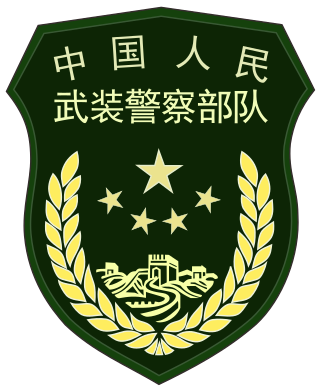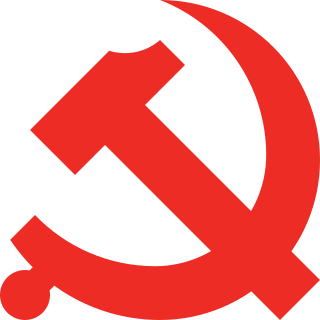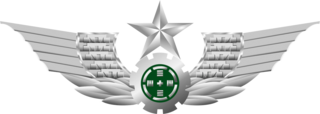The paramilitary forces of China are the military units and formations apart from the People's Liberation Army, the principal military force of the People's Republic of China. They are composed of three main forces, the People's Liberation Army reserve force, the People's Armed Police (PAP), and the Militia, and they act as auxiliaries to the active forces of the People's Liberation Army. They generally perform a wide range of roles. All together, the paramilitary has 98,854,000 troops, as of 2018. [1]
The Chinese People's Armed Police Force (PAP) is a paramilitary force primarily responsible for law enforcement, internal security, riot control and counter-terrorism during peacetime. In time of war, the PAP would be used to support the PLA, especially in counter-insurgency operations. [2] According to the constitution of the PRC, the PAP is one of three integral elements of the Chinese armed forces, along with the People's Liberation Army (PLA) and the militia and reserve forces. The China's National Defence White Paper published in 2006 claimed that the total strength of the PAP was 1.5 million people.
The role of the Militia and the degree of party and PLA control over it have varied over the years. Nowadays, the Militia numbers some 3 million service men and women. During the 1940s the militia served primarily as a PLA support force. After 1949 the party consolidated control over the country and gradually used the militia to maintain order and help the PLA with defense of the borders and coast. In the mid-1950s Minister of National Defense Peng Dehuai attempted to build a reserve system incorporating the militia.
Peng's efforts were thwarted when the party expanded the militia, assigning it duties as a production force and internal security force during the Great Leap Forward. Lin Biao reduced the size of the militia and reemphasized military training in the early 1960s. The militia was fragmented during the early years of the Cultural Revolution, but in the 1970s it was rebuilt and redirected to support the PLA.
The Gang of Four attempted to build up the urban militia as an alternative to the PLA, but the urban militia failed to support the Gang of Four in 1976, when Hua Guofeng and moderate military leaders deposed them. The militia's logistical support of the PLA was essential during the Sino-Vietnamese War of 1979. In the 1980s Chinese leaders undertook to improve the militia's military capabilities by reducing its size and its economic tasks. when China was founded, CPC claimed a militia of 5.5 million.
In 1987 the militia was controlled by the PLA at the military district level and by people's armed forces departments, which devolved to civilian control at the county and city levels as part of the reduction in force. The militia was a smaller force than previously, consisting of 4.3 million basic or primary—armed—militia, and the 6-million-strong general or ordinary militia. The basic militia was made up of men and women aged eighteen to twenty-eight who had served or were expected to serve in the PLA and who received thirty to forty days of military training per year.
The basic militia included naval militia, which operated armed fishing trawlers and coastal defense units, as well as specialized detachments, such as air defense, artillery, communications, antichemical, reconnaissance, and engineering units, which served the PLA. The ordinary militia included men aged eighteen to thirty-five who met the criteria for military service - they received some basic military training but generally were unarmed.
The ordinary militia had some air defense duties and included the urban militia. Efforts were made to streamline militia organization and upgrade militia weaponry. By 1986 militia training bases had been established in over half the counties and cities in the nation.
The militia's principal tasks in the 1980s were to assist in production, to undergo military training, and to defend China's frontiers in peacetime. In wartime, the militia would supply reserves for mobilization, provide logistical support to the PLA, and conduct guerrilla operations behind enemy lines.
The 1984 Military Service Law stipulated the combination of the militia and the reserve service system. Military training for senior middle-school and college and university students commenced in 1984 as China sought to provide additional qualified reserve service officers. The reserve force consisted primarily of the militia and was organized into reserve-service divisions and regiments.
In 1987 China began to make reference to the National Defense Reserve Force, which apparently consisted of reserve soldiers (including all militia, demobilized soldiers, and specialized technical personnel registered for reserve service) and reserve officers (including demobilized officers and soldiers assigned to reserve officer service, college and university graduates, and civilian officials and specialized technicians). The Reserve, as of 2016, is made up of 510,000 reserve personnel of all ranks.
Before the Cultural Revolution, the Production and Construction Corps was a paramilitary organization of 3 to 4 million people under joint government, party, and PLA control. The Production and Construction Corps was used in remote and unproductive areas to build roads, reclaim land, construct defense and water works, and operate mines, state farms, and industrial plants. A secondary role was border defense, and some units were armed with light infantry weapons. All received basic military training.
Unlike the militia, Production and Construction Corps personnel were full-time and uniformed. The PLA took over the Production and Construction Corps during the Cultural Revolution, then civilianized it in the 1970s. In the 1980s the corps appeared to have been abolished except in Xinjiang. There it operated under regional party and government organizations, the Xinjiang Military District, and the Ministry of Agriculture, Animal Husbandry, and Fishery.

A militia is generally an army or some other fighting organization of non-professional and/or part-time soldiers; citizens of a country, or subjects of a state, who may perform military service during a time of need, as opposed to a professional force of regular, full-time military personnel; or, historically, to members of a warrior-nobility class. When acting independently militias are generally unable to hold ground against regular forces; militias commonly support regular troops by skirmishing, holding fortifications, or conducting irregular warfare, instead of undertaking offensive campaigns by themselves. Local civilian laws often limit militias to serve only in their home region, and to serve only for a limited time; this further reduces their use in long military campaigns. Militias may also, however, serve as a pool of available manpower for regular forces to draw from, particularly in emergencies.

The People's Liberation Army (PLA) is the armed wing of the Chinese Communist Party (CCP) and the principal military force of the People's Republic of China. The PLA consists of five service branches: the Ground Force, Navy, Air Force, Rocket Force, and Strategic Support Force. It is under the leadership of the Central Military Commission (CMC) with its chairman as commander-in-chief.

A paramilitary is an organization whose structure, tactics, training, subculture, and (often) function are similar to those of a professional military, but which is not part of a country's official or legitimate armed forces. Paramilitary units carry out duties that a country's military or police forces are unable or unwilling to handle. Other organizations may be considered paramilitaries by structure alone, despite being unarmed or lacking a combat role.

The Chinese People's Armed Police Force is a Chinese paramilitary organization primarily responsible for internal security, riot control, counter-terrorism, disaster response, law enforcement and maritime rights protection as well as providing support to the People's Liberation Army Ground Force (PLAGF) during wartime.

The Central Military Commission (CMC) is the highest national defense organization in the People's Republic of China, which heads the People's Liberation Army (PLA), the People's Armed Police (PAP), and the Militia of China.

Law enforcement in China consists of an extensive public security system and a variety of enforcement procedures used to maintain order in the country. Along with the courts and procuratorates, the country's judicial and public security agencies include the Ministry of Public Security (MPS) and the Ministry of State Security (MSS), with their descending hierarchy of departments, bureaus, subbureaus, and stations.

A gendarmerie is a military force with law enforcement duties among the civilian population. The term gendarme is derived from the medieval French expression gens d'armes, which translates to "men-at-arms", or "rural police". In France and some Francophone nations, the gendarmerie is a branch of the armed forces that is responsible for internal security in parts of the territory, with additional duties as military police for the armed forces. It was introduced to several other Western European countries during the Napoleonic conquests. In the mid-twentieth century, a number of former French mandates and colonial possessions adopted a gendarmerie after independence. A similar concept exists in Eastern Europe in the form of Internal Troops, which are present in many countries of the former Soviet Union and its former allied countries.

The People's Liberation Army Air Force, also referred to as the Chinese Air Force (中国空军) or the People's Air Force (人民空军), is an aerial service branch of the People's Liberation Army, the military force of the People's Republic of China. The PLAAF was officially established on 11 November 1949 and it is composed of five branches: aviation, ground-based air defense, radar, Airborne Corps and other support elements.

The People's Liberation Army Ground Force is the land-based service branch of the People's Liberation Army and the largest and oldest branch of the entire Chinese armed forces. The PLAGF can trace its lineage from 1927 as the Chinese Red Army; however, it was not officially established until 1948.

The People's Liberation Army Navy Marine Corps (PLANMC), also known as the People's Liberation Army Marine Corps (PLAMC), is the marine force of the People's Liberation Army (PLA) and one of five major branches of the PLA Navy (PLAN) responsible for amphibious warfare, expeditionary operations and rapid responses. It currently consists of seven 6,000-man combined armed brigades and four other supporting brigades including aviation, engineering & chemical defense, artillery and service-support brigades for a total of 40,000. It further includes a brigade-level special operations unit called "Jiaolong Commando Unit"

Taiwan, officially the Republic of China (ROC), maintains an active conscription system in accordance with the regulations set by the government of the Republic of China. All qualified male citizens of military age in the country are obligated to perform 1 year on active duty military service or receive 4 months of military training.

A military reserve force is a military organization whose members (reservists) have military and civilian occupations. They are not normally kept under arms, and their main role is to be available when their military requires additional manpower. Reserve forces are generally considered part of a permanent standing body of armed forces, and allow a nation to reduce its peacetime military expenditures and maintain a force prepared for war. During peacetime, reservists typically serve part-time alongside a civilian job, although most reserve forces have a significant permanent full-time component as well. Reservists may be deployed for weeks or months-long missions during peacetime to support specific operations. During wartime, reservists may be kept in service for months or years at a time, although typically not for as long as active duty soldiers.

Type 07 is a group of military uniforms used by all branches of the People's Liberation Army (PLA) of the People's Republic of China (PRC) and the paramilitary Chinese People's Armed Police Force. Introduced in 2007, the Type 07 uniforms replaced the Type 87 service uniforms used by regular units and the Type 97 Service Dress uniforms of the People's Liberation Army Hong Kong Garrison and the People's Liberation Army Macau Garrison. The Type 07 uniforms were first seen in late June 2007 during a celebration ceremony for the 10th anniversary of the Transfer of sovereignty over Hong Kong.
The military modernization program of the People's Liberation Army (PLA) which began in the late 1970s had three major focuses. First, under the political leadership of 3rd paramount leader Deng Xiaoping, the military became disengaged from civilian politics and, for the most part, resumed the political quiescence that characterized its pre-Cultural Revolution role. Deng reestablished civilian control over the military by appointing his supporters to key military leadership positions, by reducing the scope of the PLA's domestic non-military role, and by revitalizing the party political structure and ideological control system within the PLA.
The national security of China is the coordination of a variety of organizations, including law enforcement, military, paramilitary, governmental, and intelligence agencies that aim to ensure China's national security. China considers three factors in its national security: national sovereignty, security, and development interests.

The Militia or Militia of China is the militia part of the armed forces of China, other two parts being the People's Liberation Army (PLA) and the People's Armed Police (PAP). The Militia is under the leadership of the Chinese Communist Party (CCP) and serves as an auxiliary and reserve force for the PLA. It is one of the largest militias in the world.

The People's Liberation Army Air Force Airborne Corps is an airborne corps under direct command of the People's Liberation Army Air Force (PLAAF). It was reorganized and renamed from the 15th Airborne Corps in May 2017 and now comprises six airborne brigades and a special operations brigade. The PLAAF Airborne Corps is China's primary strategic airborne unit and part of the newly formed rapid reaction units (RRUs) of the Chinese military which is primarily designated for airborne and special operation missions. Its role is similar to that of the U.S. Army's XVIII Airborne Corps, the British Army's Parachute Regiment and the Russian Airborne Forces.

The National Day Parade, officially the National Day of the People's Republic of China Parade, is a civil-military parade event held at Tiananmen Square in Beijing, the capital of the People's Republic of China, on the National Day of the People's Republic of China on 1 October. It is organized by the People's Liberation Army, the People's Armed Police and the Militia, as well as civilian groups of the Chinese Communist Party (CCP). It has been held every decade since 1959, annually from 1950 to 1959, and has been broadcast live on China Central Television since 1984.